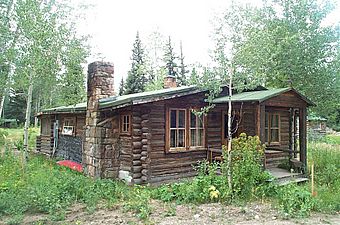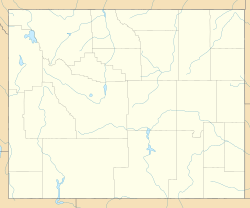Murie Ranch Historic District facts for kids
|
Murie Ranch Historic District
|
|

Estes Cabin, Murie Ranch
|
|
| Location | Grand Teton National Park, Teton County, Wyoming, USA |
|---|---|
| Nearest city | Moose, Wyoming |
| Built | 1951 |
| Architect | Estes, Buster |
| MPS | Grand Teton National Park MPS |
| NRHP reference No. | 98001039 |
Quick facts for kids Significant dates |
|
| Added to NRHP | August 24, 1998 |
| Designated NHLD | February 17, 2006 |
The Murie Ranch Historic District is a special place located inside Grand Teton National Park in Wyoming. It was also known as the STS Dude Ranch and the Stella Woodbury Summer Home. This area is very important because of its connection to famous conservationists.
These conservationists were Olaus Murie, his wife Margaret (Mardy) Murie, and Olaus's brother, scientist Adolph Murie, and his wife Louise. Olaus and Adolph Murie helped create a new way of thinking about how to manage wildlife. They believed in an "ecological approach," which means looking at how all parts of nature connect. Mardy Murie was also a huge conservation hero. She helped pass a major law called the Alaska National Interest Lands Conservation Act in 1980. For her amazing work, she received the Presidential Medal of Freedom, which is the highest award a civilian can get in the United States. Olaus Murie was also the leader of a group called the Wilderness Society. He worked hard to protect wild lands across America.
The Murie Residence, where Olaus and Mardy lived, is part of this historic district. It is also listed on the National Register of Historic Places. The Murie Residence and the STS Ranch were used for important meetings of the Wilderness Society in 1953. They also served as a home base for many writers and activists who worked to protect nature in the 1940s, 50s, and 60s.
The Murie Family and Their Work
Olaus Murie did important studies on caribou (wild reindeer) in Alaska during the 1920s. He studied how these animals lived with their environment. His younger brother, Adolph, joined him in 1922. Olaus met his future wife, Margaret "Mardy" Thomas, in Fairbanks in 1924. Adolph later married Mardy's half-sister, Louise.
In 1927, Olaus studied the elk population in Jackson Hole. He found that there were too many elk for the land to support, partly because people were feeding them. This study was a big step in understanding how all parts of an ecosystem work together.
From 1937 to 1940, Adolph Murie studied coyotes in Yellowstone National Park. His research showed that the park's policy of killing coyotes was wrong. This led to the National Park Service changing its rules. Adolph continued his studies, writing a book called The Wolves of Mount McKinley in 1944. This book also helped change how the Park Service managed wolves in Alaska.
Olaus and Mardy Murie moved to Jackson in 1927. They lived in a house they called "Pumpkin House," which is no longer there. Adolph and Louise moved to Jackson in 1939. When Grand Teton National Park was expanded to include the Jackson Hole National Monument, Olaus was on the board of the Wilderness Society. He also served on the board of Jackson Hole Preserve, Inc. This group managed lands bought to become part of the park. When the Preserve wanted to create a fenced wildlife park, Murie resigned. This caused the National Park Service to stop supporting the idea.
In 1945, Olaus Murie left his government job and became president of the Wilderness Society. He also moved to the STS property. The ranch became a place for important meetings, like the 1948 Wilderness Society Council. Many famous visitors came to the ranch. These included grizzly bear biologists John and Frank Craighead, and U.S. Supreme Court justice William O. Douglas.
Olaus wrote several books at the ranch, including The Elk of North America. Adolph wrote The Grizzlies of North America and The Wolves of Mount McKinley. Mardy Murie wrote Two in the Far North and, with Olaus, Wapiti Wilderness. The Wilderness Act, which protects millions of acres of wild land, was passed a year after Olaus Murie died in 1963. After his death, Mardy Murie joined the Wilderness Society's council. She continued Olaus's work while still living at the ranch.
Mardy wanted to honor her husband by protecting the nature they both loved. In 1980, Mardy Murie helped pass the Alaska National Interest Lands Conservation Act. This law protected one hundred million acres of land in Alaska. Mardy was a very passionate person. She could bring people together to work for conservation. She was able to connect with people of all ages and backgrounds. Mardy lived to be 101 years old and was honored by four different presidents. The singer John Denver even wrote a song about Mardy and Olaus Murie called 'A Song for All Lovers'.
The STS Ranch Story
The STS Ranch was started by Buster and Frances Estes in 1921. It was a "dude ranch," which is a ranch where guests (or "dudes") can stay and experience ranch life. Buster was from the local area. Frances first visited Jackson Hole from Philadelphia in 1914. They fell in love and got married, even though Frances's family did not approve.
In 1922, the Estes family heard that 76 acres (about 31 hectares) were available near Menor's Ferry. They built a cabin and moved in during January 1923. The dude ranch started small, with just one guest cabin and a tent. By 1927, the STS Ranch had a log cabin, two wooden cabins, a barn, a garage, and a five-room main house. The Estes family slowly grew the ranch to hold 24 guests. They charged $55 per week, which was less than other dude ranches.
The ranch did well for a while, but it was hit hard by the Great Depression. Rates went down, and part of the property was leased to the Nelson brothers. They built what later became the Murie residence. Buster and Frances built a new log house in 1940. They closed the ranch during World War II and worked in war production in Salt Lake City.
The Murie families (Adolph and Louise, and Olaus and Mardy) bought the STS Ranch in 1946. Adolph and Louise lived in the original ranch buildings. Olaus and Mardy moved into the Nelson house after 1950. The sale included a rule that the Muries could never operate the place as a dude ranch again.
Murie Ranch Buildings
The Murie property was 77 acres (about 31 hectares) next to the village of Moose. Olaus immediately took down all the fences on the property. In 1950, Olaus and Mardy bought the Nelson house and moved in. The Muries also partly dammed a small stream from the Snake River to create a swimming hole. Beavers helped finish the work! Olaus wrote about the ranch and its wildlife in his book Jackson Hole with a Naturalist.
Here are some of the main buildings at the Murie Ranch:
- The Studio: This is a one-story log building built in 1947. It has one room and a front porch. Olaus Murie used it as his studio for painting and drawing.
- Homestead Cabin/STS Lodge: This was the original home of the Estes family, built in 1925. It became the main building of the STS Ranch. It grew over time, adding a lounge, dining room, and library. The doors in this cabin are quite short because Buster Estes was short and designed them to fit him.
- Murie Residence: This one-story log house was built in 1942. It has great views of Grand Teton mountain. The original house has eight rooms, with another room added in the 1950s.
- Chena Cabin: A one-story log building with three rooms.
- Estes Cabin: This was the home of Buster and Frances Estes after their homestead cabin became the STS Lodge. It was moved to the ranch from another location and was built around 1925. After the Muries bought the ranch, Inger Koedt lived here.
- Robin's Nest Cabin: This single-room cabin is next to the Estes Cabin and was built around 1925. The Estes family used it as a bedroom for their daughter. Later, Inger Koedt used it as a guesthouse.
- Moviewood Cabin: This wooden cabin was built around 1925. It was used as an office and editing room for a documentary about Mardy Murie called Arctic Dance: The Mardy Murie Story. Today, it is an office for the Murie Foundation.
- Alatna Dulex Cabin: The Alatna was built around 1925. It is a one-story, two-room log cabin. The rooms have a door connecting them, but each also has its own outside door.
- Cabin Belvedere: A one-room log cabin built in 1925.
- Cabin Polaris: This cabin is similar to Belvedere. People once thought it was Adolph Murie's study, but that idea is now known to be incorrect.
- Montana Duplex Cabin: This 1925 cabin is divided into two equal rooms. It was used as two separate guest units, with no door connecting the inside rooms.
- Wild Lone Cabin: This one-room log cabin was built around 1925. It is located a bit further away from the main group of buildings.
Most of these cabins have an outhouse nearby. The ranch also has several garages, sheds, and other utility buildings. A barn and a storage shed were moved from the site in the 1970s.
The Murie Ranch properties were recognized as a National Historic Landmark in 2006.



